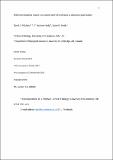Files in this item
Wild hummingbirds require a consistent view of landmarks to pinpoint a goal location
Item metadata
| dc.contributor.author | Pritchard, David J. | |
| dc.contributor.author | Hurly, T. Andrew | |
| dc.contributor.author | Healy, Susan D. | |
| dc.date.accessioned | 2019-02-19T00:33:31Z | |
| dc.date.available | 2019-02-19T00:33:31Z | |
| dc.date.issued | 2018-03 | |
| dc.identifier | 252088546 | |
| dc.identifier | 6f6eeb0f-7d36-4e5b-895d-638c4f9a6a93 | |
| dc.identifier | 85041523068 | |
| dc.identifier | 000427436600010 | |
| dc.identifier.citation | Pritchard , D J , Hurly , T A & Healy , S D 2018 , ' Wild hummingbirds require a consistent view of landmarks to pinpoint a goal location ' , Animal Behaviour , vol. 137 , pp. 83-94 . https://doi.org/10.1016/j.anbehav.2018.01.014 | en |
| dc.identifier.issn | 0003-3472 | |
| dc.identifier.other | ORCID: /0000-0002-8059-4480/work/60631296 | |
| dc.identifier.uri | https://hdl.handle.net/10023/17092 | |
| dc.description | Funding: This work was supported by the University of St Andrews, the University of Lethbridge and the Natural Sciences and Engineering Council of Canada. | en |
| dc.description.abstract | One outcome of the extensive work on the ways that birds and insects use visual landmarks to return to a rewarded location is that they use landmarks differently. But this conclusion may have been reached because the almost exclusive training and testing of birds in small laboratory environments may prevent birds from using the view-matching strategies seen in insects. To test how birds use landmarks in an open-field environment, we trained free-living hummingbirds to search for a reward near two experimental landmarks. When the angular size and panoramic position of the landmarks were kept consistent, the hummingbirds searched in the direction of the flower and matched either the retinal angle of the landmarks or the absolute distance of the flower during training, even when the actual size and distance between landmarks changed. These data are more similar to data from view-matching ants solving a similar problem than they are to data from birds trained to use landmarks in the laboratory. This suggests that hummingbirds may also use a remembered view to relocate a rewarded site. Regardless of whether hummingbirds use a remembered view for navigation or just to recognize landmarks, data on landmark use collected from birds tested in the laboratory may not fully reflect how birds return to locations in the wild. | |
| dc.format.extent | 12 | |
| dc.format.extent | 1296929 | |
| dc.language.iso | eng | |
| dc.relation.ispartof | Animal Behaviour | en |
| dc.subject | Spatial cognition | en |
| dc.subject | Navigation | en |
| dc.subject | Landmark | en |
| dc.subject | Spatial learning | en |
| dc.subject | Hummingbird | en |
| dc.subject | QH301 Biology | en |
| dc.subject | NDAS | en |
| dc.subject.lcc | QH301 | en |
| dc.title | Wild hummingbirds require a consistent view of landmarks to pinpoint a goal location | en |
| dc.type | Journal article | en |
| dc.contributor.institution | University of St Andrews. School of Biology | en |
| dc.contributor.institution | University of St Andrews. Institute of Behavioural and Neural Sciences | en |
| dc.contributor.institution | University of St Andrews. Centre for Social Learning & Cognitive Evolution | en |
| dc.contributor.institution | University of St Andrews. Centre for Biological Diversity | en |
| dc.identifier.doi | 10.1016/j.anbehav.2018.01.014 | |
| dc.description.status | Peer reviewed | en |
| dc.date.embargoedUntil | 2019-02-19 |
This item appears in the following Collection(s)
Items in the St Andrews Research Repository are protected by copyright, with all rights reserved, unless otherwise indicated.

